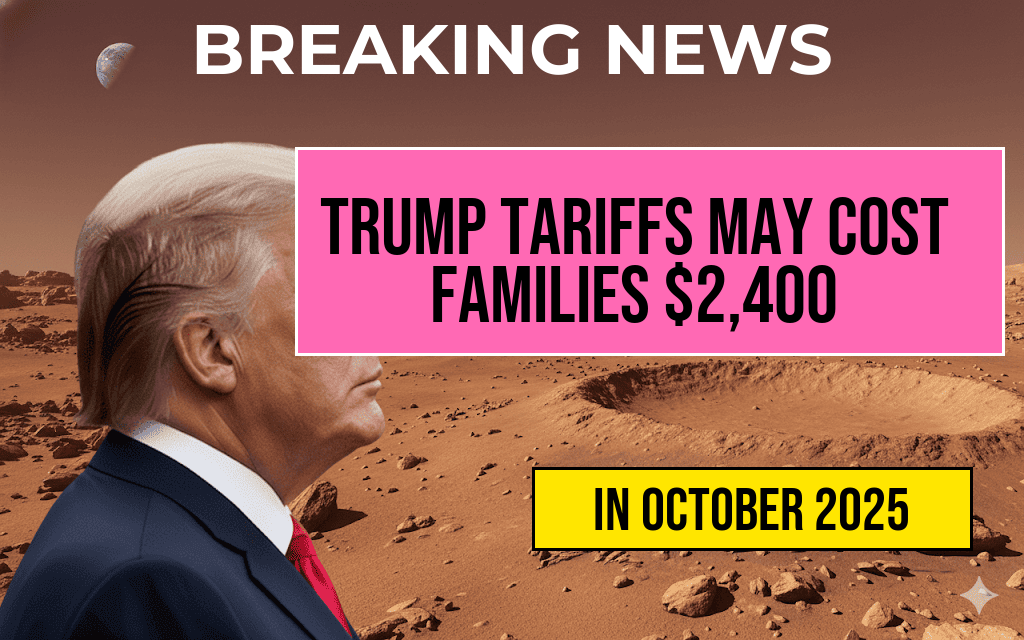Recent analyses suggest that the reintroduction or escalation of Trump tariffs could impose an additional $2,400 annually on the average American family’s expenses. This potential increase stems from the ongoing debate over tariffs imposed on Chinese imports and other foreign goods, which many economists warn could ripple through the economy, raising costs for consumers across a broad spectrum of products. While policymakers argue tariffs protect domestic industries and jobs, critics contend that such measures translate into higher prices at the checkout counter, effectively creating a “turbulence tax” on household budgets. As the government considers adjustments to trade policies amidst global economic shifts, families are left contemplating how these changes could impact their financial stability in the months ahead.
The Potential Financial Impact of Tariffs on American Households
Quantifying the Cost Increase
Experts estimate that if recent proposals to expand or reinstate tariffs are fully enacted, the typical U.S. family could face an additional $2,400 annually. This figure is derived from an analysis of consumer spending patterns, tariff rates, and the increased costs passed down through supply chains. According to the U.S. Census Bureau, the average household spends approximately $7,000 on goods and services susceptible to tariffs, including electronics, clothing, and household appliances.
| Category | Current Annual Spending | Projected Additional Cost | Total Estimated Increase |
|---|---|---|---|
| Electronics & Appliances | $2,000 | $400 | $2,400 |
| Clothing & Footwear | $1,400 | $250 | |
| Furniture & Household Goods | $1,200 | $300 | |
| Food & Beverages | $2,400 | $200 | |
| Transportation | $1,000 | $150 | |
| Total | $7,200 | $1,300 | $2,400 |
Underlying Factors Driving Cost Increases
The core of the tariff impact lies in the increased costs for importing goods. When tariffs are applied, importers often pass these expenses onto consumers, resulting in higher retail prices. Additionally, supply chain disruptions caused by tariffs can lead to shortages or delays, further inflating costs. As tariffs affect a wide range of products—from consumer electronics to apparel—the cumulative effect can significantly strain family budgets, especially for lower- and middle-income households.
Economic Perspectives on Tariffs and Household Expenses
Supporters’ Viewpoint
Proponents of tariffs argue that they serve as a strategic tool to rebalance trade relationships and bolster domestic manufacturing. They contend that protective tariffs can lead to job creation within certain sectors and reduce reliance on foreign imports. From this perspective, the short-term cost increases to consumers are viewed as an investment in long-term economic stability and national security.
Critics’ Concerns
Conversely, economists and consumer advocates warn that tariffs act as a hidden tax on families. The Forbes reports that rising import costs often lead to inflationary pressures, diminishing household purchasing power. The “turbulence tax” metaphor captures how these additional expenses can destabilize family finances, especially during periods of economic uncertainty or rising living costs.
Potential Policy Responses and Consumer Strategies
Government Measures
- Adjusting tariff rates or providing targeted relief for essential goods.
- Implementing subsidies or tax credits aimed at offsetting increased consumer costs.
- Streamlining supply chains to reduce import costs independent of tariffs.
What Families Can Do
- Shop for alternatives or domestically produced goods to mitigate price hikes.
- Review household budgets to identify areas where expenses can be minimized.
- Stay informed about trade policy developments that could influence prices.
Looking Ahead: Navigating the ‘Turbulence Tax’
The prospect of increased tariffs underscores the importance of strategic financial planning for American households. While the debate over trade policies continues, families are advised to remain vigilant about price changes and consider proactive measures to shield themselves from potential financial strain. As policymakers weigh the benefits of tariffs against their broader economic implications, understanding how these measures translate into real-world costs is essential for making informed household decisions and advocating for balanced trade approaches.
For more insights on how tariffs influence the economy, visit Wikipedia’s coverage on tariffs and Forbes’ economic analysis.
Frequently Asked Questions
What are the Trump tariffs and how do they affect family expenses?
The Trump tariffs refer to import taxes implemented during President Trump’s administration, which increase the cost of imported goods. These tariffs can lead to higher prices for everyday products, thereby potentially adding around $2,400 annually to a typical family’s expenses.
What is the ‘Turbulence Tax’ mentioned in the article?
The ‘Turbulence Tax’ is a term used to describe the economic impact of tariffs and trade disruptions that cause price increases and market instability, ultimately leading to higher costs for consumers and families.
How do tariffs specifically impact the prices of goods families purchase regularly?
Tariffs increase the cost of imported goods, such as electronics, clothing, and household items. These higher costs are often passed down to consumers, resulting in increased prices for products families buy on a regular basis.
Are there any ways families can mitigate the financial impact of these tariffs?
Families can mitigate the impact by shopping for domestic alternatives, seeking out sales and discounts, and adjusting their budgets to accommodate potential price increases caused by tariffs.
What can policymakers do to reduce the financial burden of tariffs on families?
Policymakers could consider negotiating trade agreements that lower tariffs, implementing targeted relief measures, or providing support programs to help families offset the increased costs associated with tariffs and trade turbulence.

Leave a Reply